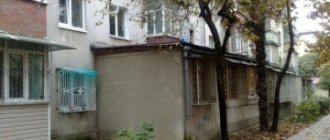Pavilion without a passport
Our story began in the courts of the Krasnodar region, and ended in the capital, in the Supreme Court. And given that we have a lot of unauthorized buildings of various sizes and purposes in our country, such an explanation from highly qualified judges can be very useful to a considerable number of citizens.
The story began a long time ago - in the late 90s. Then the local administration leased a plot of land for use as a shopping pavilion. But there was an important caveat - the pavilion was not supposed to be a permanent structure. Over the years, the tenants changed, until the next tenant decided that he wanted to have a permanent building. He built a reinforced concrete foundation, erected brick walls and went to court to recognize ownership of the property. The regional court did not see anything illegal in this and satisfied the demand. But the Supreme Court did not agree with this decision and stated that the will of the owner must be taken into account.
And now the details of the dispute. In 1996, the administration leased the site to a certain local company for five years. The documents said: “For the installation and operation of a trade pavilion.” The tent was built and the lease was extended.
In 2003, the land was given to a certain citizen on lease from the administration for three years “to accommodate a trade pavilion made of lightweight structures.” But the citizen reconstructed the facility: he made a foundation from a reinforced concrete slab and erected brick walls. The new tenant eventually came to the conclusion that his, now permanent, pavilion had become real estate. And if so, he asked the court to recognize ownership of this building.
The one who erected an unauthorized structure does not acquire actual ownership of it.
At first, this request was considered by the Prikubansky District Court of Krasnodar. The court rejected the citizen's claim. In its decision, the district court indicated that the land plot was provided to the plaintiff for three years for the “temporary placement of a trade pavilion made of lightweight structures.” The plaintiff does not have any permitting documentation for capital construction required in such cases. And he is not the owner of the land plot.
According to the court, this capital structure is a real unauthorized construction, erected without the appropriate permission. As a result, the district court wrote in its decision that the citizen violated the legal rights and interests of the owner of the land plot - the municipality of Krasnodar.
The offended owner of the pavilion went to challenge the decision. And he succeeded. The Krasnodar Regional Court overturned the decision and adopted a new decision. Namely, it satisfied the claims. In its decision, the regional court stated verbatim the following: on the basis of the purchase and sale agreement for the shopping pavilion, the plaintiff became its owner, carried out reconstruction, after which the pavilion began to have “features of real estate.”
Thus, according to the appeal, it is quite possible for a citizen to recognize the right of ownership of the pavilion as a newly created thing. And he referred to articles 218-219 of the Civil Code of the Russian Federation.
The administration of the municipality of the city of Krasnodar was already indignant at this decision. And she filed a cassation appeal to the Supreme Court. There they examined the complaints and stated that the person who erected the unauthorized structure does not acquire ownership of it and does not have the right to dispose of it. The Supreme Court reminded its colleagues about another article of the Civil Code, which is more suitable for this case - Article 222.
And this article says that if a site is leased for the construction of temporary buildings or easily erected structures, then there is no reason to recognize ownership of the “actually erected capital type structure.” By concluding a lease agreement, the owner must clearly express his will to erect buildings of a specific type.
According to the Supreme Court of the Russian Federation, when considering the issue of recognizing the ownership of an unauthorized object, the will of the owner of the land plot is of particular importance. Our hero received land lease for the temporary placement of a trade pavilion made of lightweight structures. Without the right of capital construction and without corresponding permitted use. The right of ownership of newly created real estate is recognized only if all legal norms are observed during its creation. Consequently, we are no longer talking about unauthorized construction. Therefore, the Supreme Court of the Russian Federation canceled the appeal ruling and upheld the decision of the trial court.
What is an “extension” and why should it be legalized?
An extension is a part of a building erected on the local area after the construction of the house has been completed and it has been put into operation, that is, this area was not included in the plan . Any documentation for the house should be put in order in a timely manner, otherwise you will not be able to take any legal actions with the property. The legalization of the extension is carried out with the help of a court in civil proceedings. You file a claim and the local municipality is the defendant.
Is it possible to legalize squatter construction?
Self-construction can be legalized, but subject to specific conditions:
- the plot is registered as the property;
- the category of land allows the construction of real estate;
- government services have no claims to the constructed structure;
- the owner has paid all mandatory taxes and fines for the last 3 years, provided for by tax legislation.
If the ownership rights to the plot have been assigned to the owner for more than 10 years, then taxes can be collected for the entire period.
In any case, when legitimizing unauthorized construction, you will need to adhere to the regulations. If you ignore legal requirements, the owner needs to be prepared for the consequences.
What is considered self-construction?
Self-construction is recognized as an object with a number of characteristics:
- Erected on a site that was not properly registered as a full-fledged property.
- The structure was built on land whose intended purpose does not imply construction within its boundaries.
- A house or other structure was erected without approval from administrative departments.
- Construction took place in disregard of urban planning standards and other requirements. For example, fire safety rules or installations of the sanitary and epidemiological service.
The construction is not unauthorized if the owner was not notified or could not have known about the existing restrictions, therefore exaction measures cannot be taken against him.
If the object corresponds to at least one of these positions, then the owner needs to be prepared for exacting and restrictive measures on the part of controlling structures. In order to prevent such a development of events, it is necessary to resolve the issue regarding the legalization of the structure.
How to make a project?
When choosing a construction project, it is important to pay attention to the following factors:
- Technical feasibility;
- Functionality;
- Compliance with building codes.
Extensions are made to increase the area of the house or make the entrance more convenient. Project in Fig. 1 increases the living space by 2 times. It is carried out by completing three walls and adding ceiling beams to expand one of the roof slopes.
Rice. 1
Project in Fig. 2 increases the area of the first floor only and has a separate roof.
Rice. 2
Project in Fig. 3 It is an extension to the wall with an entrance door. One of the popular options serves as a hallway and entrance porch with wooden steps.
Rice. 3
An extension to the house allows you to profitably increase its area. To avoid having to collect a lot of certificates and go to court after construction is completed, you should obtain a construction permit in advance and comply with the norms of capital buildings.
Is it possible to legalize construction on your own plot and on municipal land?
Legalizing unauthorized construction in 2021 through the court is a promising solution if:
- the developer has the right to build on this land plot (for example, he owns the land or has leased it for construction);
- the construction does not violate construction and urban planning standards;
- it is safe and does not violate the rights of other persons (for example, the owners of a neighboring plot, the holder of an easement on a plot under an unauthorized building).
All these conditions must be met simultaneously. If at least one of them is violated, then you should first eliminate the violation, and only then go to court (clause 3 of Article 222 of the Civil Code of the Russian Federation).
Ways to resolve the issue of legalizing an extension with example prices
This procedure includes the following costs:
- The state fee is 200-500 rubles .
- Cadastral chamber services - 20,000 rubles .
- Expertise carried out in court - 15,000 rubles .
This “minimum” set is suitable for those who deal with this issue on their own. These payments are mandatory and, unfortunately, cannot be avoided.
The situation is completely different for those who decide to seek the help of a lawyer. A one-time consultation costs about 1000 rubles. , representation in litigation 1 time – 6 tr. , on an ongoing basis - from 30 tr . Don’t forget about the power of attorney for the representative, executed by a notary – 2 tr .
What is the cost of legalizing an extension?
If the amounts given above seem illegally extortionate, then let’s figure out what the procedure for legitimizing an extension consists of. Let's start with the fact that the construction of an extension requires permission from local authorities. That is, ideally the procedure is as follows:
- Obtaining permission for an extension.
- Construction of an extension.
- Legalization of the extension.
But often citizens skip the first point, some intentionally, some out of ignorance, but, as they say, ignorance of the law does not exempt you from responsibility, so sooner or later it will still have to be brought into line with the norms of the law. I would like to note that option 1 will cost much less, because if you “accidentally” missed obtaining a building permit, then the extension is considered unauthorized and is subject to demolition. In this case, you first need to prove its legality , and then only start the process of legalizing it.
Also, the difference in price is mainly due to the participation of a representative by proxy . Drawing up a claim, submitting requests for examinations, collecting and analyzing available documents - this is all the work of lawyers. If you understand these subtleties, then the costs will only be in terms of examinations and state payments. duties. It can be assumed that you do not know everything thoroughly, but only have a general idea. Then it would be advisable for you to seek the help of a professional .
The difference in the procedure and prices for legalizing an “extension” and an “unauthorized extension”
Registration of an extension for which permission has been given from the administration begins with the payment of state fees. duties in the amount of 350 rubles .
If an extension is planned during the construction phase of a residential building, the technical plan and design of the house should be agreed upon. Coordination of redevelopment – 20 tr. , reworking the technical plan and other documentation - 10 tr . If construction is nearing completion, no adjustments or approvals are required.
During the trial, it will be necessary to carry out an examination of the building - 15 tr . To legalize an unauthorized extension, you must first justify its safety; this work is carried out by a visiting engineering team - from 2500 to 5000 rubles .
And the most unpleasant part of this procedure is paying the fine:
- For the construction of an extension without permission - 2000-5000 rubles , based on Art. 9.5 Code of Administrative Offences.
- For using an unauthorized extension - 500-1000 rubles under the same article.








